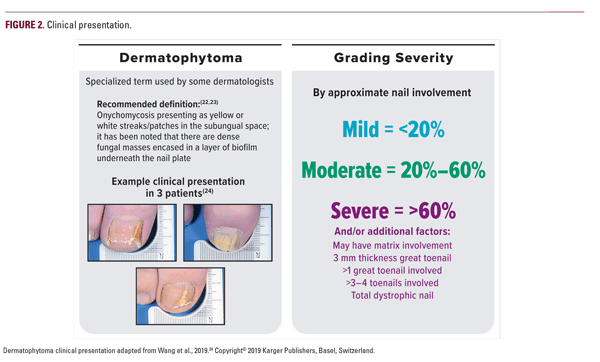
so care must be taken to distinguish between contaminants and pathogens. Results may be corroborated with a fungal culture.
While onychomycosis diagnosis still requires in-person visits for nail sampling, telemedicine has been useful during the COVID-19 pandemic to limit face-to-face interactions and reduce spread of coronavirus.21 Outside of the COVID-19 pandemic, however, telemedicine may be best for follow-up visits.
Typical clinical features of onychomycosis comprise one or more of the following: nail plate longitudinal ridging and/or splitting; onycholysis; subungual hyperkeratosis; nail plate thickening and/or crumbling; and nail discoloration (yellow, brown, black, or white).13 Clinical patterns of onychomycosis are: distal lateral subungual (DLSO), superficial white, proximal subungual, endonyx, and total dystrophic; DLSO is the most common subtype.20
In addition to a standard clinical pattern, some patients may present with yellow or white streaks/patches in the subungual space (Figure 2); underneath the nail plate, it has been noted that there are dense fungal masses encased in a layer of biofilm. These have been referred to as dermatophytomas by some dermatologists,22,23 though this term may be less commonly used by podiatrists and other clinicians. Presentation is not as well defined and there are limited data on treatment, as these patients are often excluded from clinical trials. While dermatophytomas are reportedly less responsive to oral antifungal therapy, topical efinaconazole 10% has been used successfully.24
Disease severity should be determined via percent nail surface area involvement, nail thickness, and number of nails involved. The authors-recommended onychomycosis severity definitions are shown in Figure 2.
Efficacy and Safety of Treatments and Medications
When treating onychomycosis, there are multiple endpoints that can be used to assess efficacy. Clinical trials typically use mycologic cure (negative KOH and negative culture), clinical cure (clinically completely normal nail), and complete cure (mycologic cure and clinical cure).25 Physicians may be interested in mycologic cure as an objective endpoint, but in the clinic, both physicians and patients are most interested in clinical cure/clear nail.
Onychomycosis can be managed using surgery, devices, oral or topical medications, or combinations thereof. Nail debridement can be used as an adjunct with pharmaceutical treatments13,14 while surgical nail avulsion is generally no longer recommended,12 except in specific limited situations such as a single nail which is painful and/or not growing






